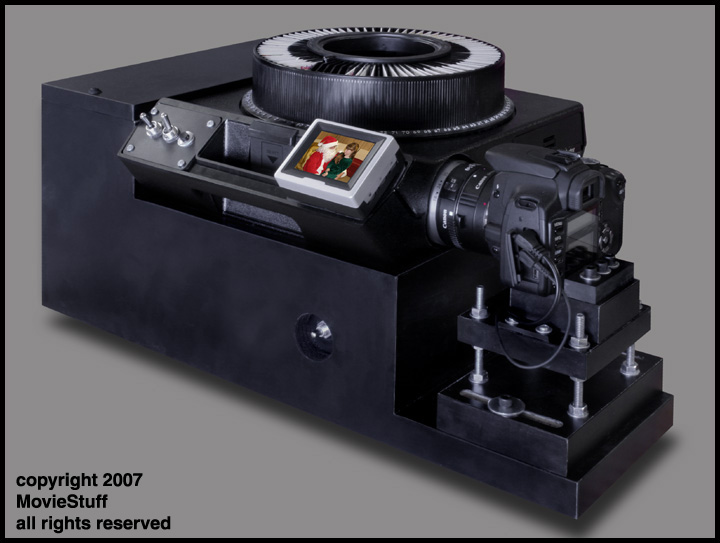clivetobin wrote:
How do you handle those pesky vertical slides?
The operator does have to turn all vertical slides on their sides, if they want full resolution. The lens can be pulled back to capture the vertical as a horitzontal but that cuts the resolution in half (though it still looks very good). I had considered making the camera mount orientable so that it could be turned 90 degrees to accomodate an entire tray of verticals but, realistically, most slides in trays are horizontal or are a mixture. I decided that it was better to have the camera mount solid and immovable once it was locked down, since the operator would be handling it a lot taking the flash card in and out. Having to prep the tray is actually easier than going through all the slides and cropping them later just to accomodate the minority of verticals. However, we will eventually be offering a software solution to automate that very function. At that point, the camera could be pulled back and all slides would be shot "as is", regarding orientation, and the software will sort out the cropping.
clivetobin wrote:At one time I was daydreaming about a gadget to copy peoples' photo prints to video, using a flat version of a Carousel and automatic timing and indexing, with an operator manually loading and removing the prints, but I decided not to bother with it. Partly because of the different photo sizes, shapes and orientation.
Great minds think alike. Yes, a rotating table with fields marked on the outer edge had entered my mind, as well. A very workable idea but I abandoned it because of the size. It would be a huge thing to ship and take up too much room, especially if you wanted to handle 8 x 10 prints. What we tried, instead, was just a two field base that slides left and right. You load a print onto the left end, slide it to the right and that action automatically starts the copy, write process for that image while you load the right end. Then you slide it to the left to capture that image, etc. However, initial tests show that the two field approach, like the circular idea, really doesn't save that much time, compared to just having a base with fields marked off, like a regular copy stand. Also, a vacuum base is really more ideal for handling small, curled photos. Our next design is incorporating a vacuum base and a modified Rebel zoom that will allow the operator to have electronic control over the cropping and a foot pedal to start the vacuum, capture, and release sequence. I think that is going to be the most practical and easier to ship, too!
clivetobin wrote:Looks like an excellent product, and I hope you have good luck with it. So much in fact that you will want to give up making movie transfer equipment, and give up the market to some other company making it that will be nameless.

Hah! Be careful what you wish for!
Considering how broke we were when we started this company, having lost our business and our home in the floods of Alison, I am obviously very grateful for the success we've had. I do not take it for granted. However, after 5+ years and 2000+ units, it sometimes feels like a weight around my ankle. I'm a film maker at heart I long to get back to making films and being creative. Thank god I rediscovered painting or I really think I would have lost my mind by now. However, I really do love interacting with my customers and I've made friends all over the world that I didn't have 5 years ago. I also like the creative aspect of designing equipment, so I don't hate what I do. In fact, I really love it. But no vacation in 5 years makes Jack a dull boy (and grumpy). We're just about through moving the rest of our shop to Utopia and I'm training some new people to take on more of the final QC and that should give me some breathing room. It sounds like your company is doing quite well. I'm sure you'll get all the business you can handle. But, as I say, be careful what you wish for.....

Roger

